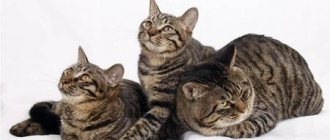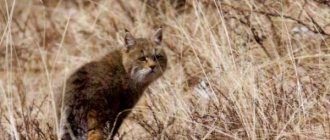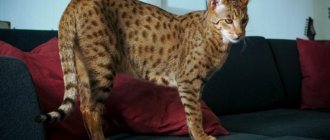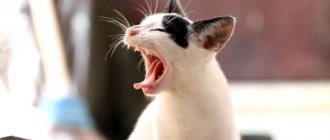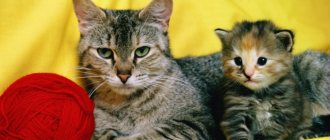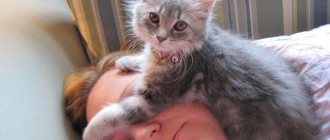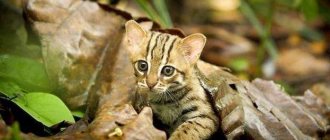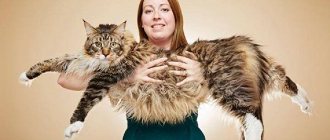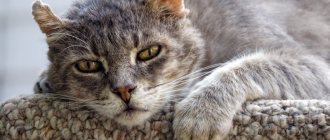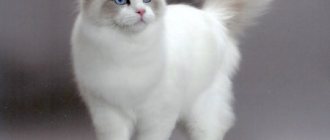Add a pet Add a video
Description of the breed
Dragon Li is a Chinese cat breed, very popular in its homeland, as well as in the United States. These cats were first presented in 2003 at one of the Beijing exhibitions, but the breed received official recognition only in 2010. Despite these figures, cats of the Li Hua breed are not at all new. They have been living in China for quite some time. It is believed that these are descendants of ancient cats that inhabited the mountains many centuries ago.
Dragon Lee is one of the ten most popular tabby cats in the United States, occupying an honorable third place. But in Russia this breed did not take root. Li Mao is too similar to our simple yard tabby cats.
Breed characteristics
COUNTRY OF ORIGIN
China
EXTERIOR
Stocky, muscular cat. Strong, rectangular body with a broad chest, longer than tall. The nose is straight and long, with a slight depression at the bridge of the nose. Large almond-shaped eyes, green preferred, but may be brown or yellow. The legs are strong, straight, the front legs are slightly shorter. The tail is slightly shorter than the length of the body.
SIZE
Average
COLOR
Short, thick coat, lying close to the body. The color is always brown. Each hair is ticked: either dark at the roots, and then becomes lighter, or light at the roots, but with a black tip. The underbelly is brownish-yellow.
PECULIARITIES
Smart, modest, well-mannered, loving, faithful, gentle cat.
History and breed standard
First of all, it is worth saying that the name “Dragon Li” is used only in Western countries and is used more for commercial purposes. Apparently to emphasize the ancient Chinese origin. In their homeland they are better known as Li Hua or Li Mao.
There is no exact information about the origin of these cats. It is only known that the Chinese consider Li Mao to be the descendants of Chinese mountain cats, which were subsequently domesticated.
Li Hua was first presented to the public in 2003. The preliminary standard for the breed was written in 2005, but the Li dragon received recognition only in 2010. At the same time, the first representatives of the breed were exported from China. Their popularity is quite high in China, as well as in the USA. In Europe, these cats are extremely rare, and in the CIS countries they are not known at all. Today, the Li dragon is considered one of the rarest cat breeds in the world.
Step six: choosing a kitten
Decide on the gender of the kitten.
You cannot buy kittens for breeding at a distance, especially since they are unlikely to be sold this way. You should personally visit the nurseries and carefully touch and examine all kittens. It is best to take with you for consultation another, more tidy breeder or at least a veterinarian. It would be preferable if such a breeder would also breed Li Hua Mao, but given the realities of the Russian felinological world, this is practically unrealistic. When examining kittens, you should pay attention first of all to their compliance with the standard, as well as to the presence of possible defects such as polydactyly or hernias. And don’t be shy to ask the breeder-seller questions.
External signs
At first glance, Dragon Li is no different from a mongrel domestic cat and an ignorant person cannot distinguish them. But of course, differences exist. Li Mao is a large, muscular cat with strong, strong legs and an even posture. Unlike most breeds, Li Hua's hind legs are the same length as her front legs. The tail is proportional to the length of the body and is quite thick.
The shape of the head is slightly elongated and has a graceful round forehead. The cat's face is round with an even profile and a massive chin. The eyes are the highlight of this breed. They have an almond shape and a slightly slanted fit. Eye color can be yellow or green.
Li Hua's coat is two-layered, thick and densely packed, but has practically no undercoat. Males' coats are usually rougher to the touch than cats'. The only color recognized as a standard is brown tabby. Black stripes should be on the head and throughout the body, the tail is covered with black rings, the tip is completely colored. Each individual hair of fur is colored in three shades: black, brown and light brown.
Appearance
The Chinese dragon is a strong, well-built large cat. Males weigh from 4.5 to 6 kg, females from 3 to 4 kg.
The head is round, with prominent cheeks, large ears and a wide base. The eyes are large, almond-shaped, yellow is preferred, green is acceptable but not highly valued. The nose is dark brown or black. The width of the nose corresponds to the size of the eye. The chin is well developed and flat. Compact build. The chest is strong, wide and deep. The neck is relatively short and thick. The muscles are very well developed, the legs and tail are of medium length, proportional to the size of the body.
The coat is short, hard, and should have a healthy glossy shine. The color is brown or dark brown tabby. Characteristic features of these cats are clear stripes or spots of a darker color, the letter M on the forehead and necklace on the chest, rings on the tail and eyeliner around the eyes.
Males continue to grow until they are three years old, which is not typical for other breeds; around the same age, their color is fully formed.
Character
The Dragon Li is an affectionate and calm breed. Although these cats cannot be called independent, they are still less affectionate towards people than most breeds. Nevertheless, they easily make contact, are sociable and playful. Li Mao get along well with other animals in the house and do not show aggression. But cats of this breed do not get along well with children. They do not show aggression towards them, but they are not in a hurry to make friends, preferring to stay at a distance from them.
This breed is well suited for keeping in an apartment. Li Hua are moderately active, but quite calm. They do not refuse to play, but when they are at home on their own, they prefer to sleep peacefully in a secluded place.
Chinese cat Dragon Li: application, character and psychology
The Chinese cat of the Dragon Li breed is considered a descendant of a wild cat; many researchers have come to the conclusion that these were once domesticated animals tamed by humans. It is advisable to keep cats of this breed in private homes where there is enough space (although many Li Huas do well in small apartments). These are excellent hunters, so they rid the house of small rodents in a short time.
Dragon Li is a freedom-loving animal that does not tolerate restrictions and infringements in space and rights. They quickly and permanently become attached to their permanent place of residence and owner.
Moving and travel are poorly tolerated, and without the owner's attention and affection they become very sad. They do not have a very positive attitude towards frequent hugs, so in a family with children, it is better to have cats of a different breed.
In general, though, Li Huas are considered friendly and playful creatures. They get along easily with some pets (cats and dogs, for example), living together with different animals proceeds calmly. But Dragon Lee does not like small inhabitants of the house (birds, hamsters, rats, reptiles) and perceives them as game, so it is better to remove them before the cat himself does it.
Dragon Li is curious, he will clean up the open closet, go out to meet the guests and check the shopping bag.
The cats are obedient and quickly get used to the feeding place, tray, and scratching post. Some owners even try to train Lee's Dragons. Cats learn quickly, as they are endowed with good intelligence.
Is the dragon able to entertain itself in the absence of its owners with toys and gaming complexes. Cats descended from representatives living in the mountains are excellent at climbing poles and hills of cat houses and complexes. Therefore, by purchasing a play set with the ability to climb, you will provide your cat with the necessary physical activity.
Education and training
The Chinese claim that a smarter and more pliable breed cannot be found. Li Hua are smart and grasp everything literally on the fly. A cat can easily be taught various commands. The main thing here is to find the right approach. These cats are very loyal to their owners and try to please them in everything. Perhaps this is precisely the secret of such pliability to training.
There is no need to raise a cat of this breed at all. The mother cat herself accustoms her children to the tray and to the designated place for eating.
Beautiful price for rare breeds
Yes, purchasing a beautiful rare cat will cost you a pretty penny. But this doesn’t stop many. Isn’t it wonderful to become the owner of a unique mustachioed creature that not only household members, but also guests will admire?
Here are the approximate prices for cats of rare breeds (in rubles):
- Dragon Li – 60-65.000
- Elf – 150-180.000
- Havana – 100-135.000
- Korat – 25-30.000
- Singapore – 120-140,000
- Khao-mani – 1,300,000
- Burmese cat – 20-35,000
- Asherah – 1,700,000
- Laperm – 270-300.000
- American Bobtail – 30-40,000
- American Curl – 65-70,000
- Ragamuffin – 55-57.000
- Napoleon – 30-40,000
- Turkish van – 60-100,000
The list of rare breeds can be continued for a very long time. Every year the world is replenished with a new unique creature, which immediately becomes someone’s favorite, companion and best friend.
But no matter how cute a rare cat may seem in a photograph, you still need to take into account the personality traits of the breed that you like. Sometimes an expensive Ashera cannot get along with the household, but a simple yard cat can become the favorite of the whole family and neighbors.
Maintenance, care, health
Li Mao reaches puberty later than other cats. An adult is considered an individual who has reached the age of three. This also determines that the kitten is not separated from its mother earlier than twelve weeks.
Dragon Li does not require extensive care. He has short hair that has virtually no undercoat. You need to comb your fur coat no more than once a week. For these purposes, a rubber massage mitten is quite suitable, which will not only remove dead hairs and improve blood circulation, but will also bring unearthly pleasure to the cat.
Bathing is recommended as needed, but not more than once a month. For bathing products, you can use both cat and regular baby shampoos.
Li Mao's cats are of aboriginal origin. They have not been crossed with other breeds, which means they do not have genetic diseases associated with this. They have good health and, with proper care, can easily live up to 18–20 years.
Health, vaccinations and nutrition of Dragon Li cats
The health of Dragon Li cats is strong, since the breed was formed independently, without artificial breeding interventions. Wild Chinese mountain cats gave their descendants strong immunity and a long active life - up to 15-16 years. Of course, this does not mean that cats can be kept in a draft or frost; a weak undercoat will not allow them to retain their own warmth for a long time.
To maintain health, the animal should be promptly vaccinated against infectious and viral diseases. The first vaccinations are prescribed at the age of 3-4 months, repeated ones are given once a year. If a cat goes on a trip or changes its place of residence, a visit to the veterinarian and additional vaccinations are required.
The Chinese prefer to feed Dragon Li with ready-made dry food, which already contains all the necessary nutrients and vitamins. The best foods are considered to be those that have a premium class.
For those who prefer natural nutrition, it makes sense to familiarize yourself with some of the nuances. Li Hua is fed boiled sea fish and given lean meat (chicken, rabbit, veal, turkey), boiled offal, vegetables, and low-fat dairy products. Cereals are recommended for cats in limited quantities. A large amount of carbohydrates leads to obesity in the animal.
Since simple food does not have the full range of vitamins and minerals that cats need, give these complexes additionally. It is forbidden to feed cats from the owners' table: sweet, salty, spicy, fried foods and any seasonings are contraindicated for them.
Experts advise feeding adult cats and female cats twice a day at the same time, calculating the portion based on the weight of the animal. For 1 kg of weight you need 40 grams of natural food or 20 grams of balanced food.
Health of Chinese cats
Since the breed of Chinese cats is indigenous and has never been subjected to selection intervention, their immunity is strong and their health is good . No hereditary diseases or frightening pathologies were found in them. Life expectancy is approximately 15–18 years.
Some owners of this breed claim that Li Huas tolerate drafts very poorly, as well as temperature changes due to their short coat and lack of undercoat.
Table: advantages and disadvantages of the Li Hua breed
| pros | Minuses |
|
|
